
Generally speaking, we tend to consider the power of the five biggest and most important tech companies — Google, Microsoft, Apple, Facebook, and Amazon — based on their tangible effects on our lives. You flick through your iPhone, you reboot your Windows operating system, you search for stuff in Google, you get updates from Facebook, and so on. Our sense of what those companies are, and how powerful they are in the ways that matter, are shaped by those day-to-day interactions. Because journalists in particular have to use Facebook in their work, for example, it’s ended up under fire in the media, tagged (not incorrectly!) as a fearsomely powerful entity with the power to control the distribution of information and news across the planet.
But Facebook is not the only powerful tech company — it just happens to be the most visible. On two different fronts this week, Amazon has showed just how much power it has to control portions of the internet, and your experiences on them. And while the fact of Amazon’s power isn’t new, the last week might reframe how casual observers of the tech industry see Amazon and its CEO, Jeff Bezos.
For the most part, if you don’t work in tech or media, you think of Amazon as a store. And it is! Its reputation is driven by its most visible business sector: its marketplace. Amazon — the company of competitively low prices and free two-day shipping. Amazon’s a one-stop shop that will connect you to someone selling a product, if they aren’t themselves.
But it’s also a lot more than a store, as this week has shown. Let’s start with yesterday’s Amazon Web Services outage, which crippled thousands of websites that rely on S3 servers to host their data.
In web hosting, AWS is a huge deal. Last quarter, the division brought in $3.5 billion in revenue; according to one survey, Amazon holds nearly half of the market share when it comes to cloud-computing services. In layman’s terms, this means a huge portion of the independent sites on the web that you might patronize likely run at least some part of their operation via AWS. That division still accounts for a small ratio of Amazon’s total revenue, but the proportions are shifting.
This makes Amazon an obvious bottleneck or pressure point when it comes to internet traffic. Like Dyn, the domain company taken down by a malicious attack last October, the AWS behemoth consolidates thousands of online targets under one umbrella. By all accounts, AWS is incredibly stable — that’s part of what makes it so popular — but what the events of Wednesday have shown us is that when it’s not stable, the web as we know it becomes erratic and unreliable. And this isn’t even Amazon actively wielding its power — we’re just talking about technical problems here.
On the other end of the spectrum from AWS is the company’s affiliate program, which allows people and businesses to earn a percentage of any sale that they refer to Amazon. Last week, the company announced that it was changing the rates for some of its payouts — specifically, it was getting rid of volume pricing. Before last week, if affiliates sold a certain amount of a product, they’d get a significant bump in their percentage of the earnings; now, those earning will remain flat regardless of how much product an affiliate moves.
The move is significant because more and more websites, particularly media companies, are turning to affiliate links as a source of revenue. Gizmodo Media Group’s Kinja Deals site covers a hefty share of their editorial budget, and the New York Times recently paid $30 million for tech-recommendation site the Wirecutter. (New York also launched an e-commerce referral venture, the Strategist, a few months ago. Please buy stuff from it.)
Just as Facebook’s changes to its News Feed algorithm can cause huge swings in a website’s traffic graphs, Amazon holds a lot of power to dictate exactly how much money others can earn from standing on its shoulders. Large affiliate operations like the one Gizmodo runs have customized business arrangements, so Amazon’s general changes to the affiliate program don’t affect them. But they do affect the independent bloggers and YouTube reviewers who rely on the affiliate program to support their businesses. That’s an enormous amount of power, and as media companies try to disentangle themselves from display-ad revenue models, it’s only going to increase.
So if this week taught us anything, it’s that Amazon isn’t just a store. It’s a platform — and not just for retail, either. Platforms — especially those foundational ones that other large companies need to function — are the best businesses to be in the new tech economy. Facebook, Apple, Google, and Microsoft don’t just want to sell you a piece of hardware or a one-time software license; they want to become a service that connects you to businesses multiple times throughout the day — and make money by doing so. Amazon has done the same thing, only it’s taken an indirect and less visible route. You might not know that the sites and apps you like are powered by Amazon, and that’s what makes it even more powerful.





























